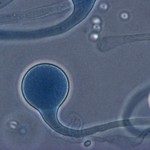Link to Pubmed [PMID] – 29656841
Med Mal Infect 2018 Jun;48(4):278-285
OBJECTIVE: Infections caused by dematiaceous fungi are more common in tropical and subtropical areas. We aimed to describe the clinical, microbiological and therapeutic aspects of case patients diagnosed at a University Hospital located on an Indian Ocean island.
PATIENTS AND METHODS: We performed an observational retrospective study of infections caused by dematiaceous fungi diagnosed at the University Hospital of Saint-Pierre, Reunion, from 2000 to 2015. Mycological identifications were performed at the National Reference Center for Invasive Mycosis and Antifungal Agents (Paris).
RESULTS: The review of clinical and microbiological data of 11 patients identified revealed that five were infected by dematiaceous fungi. Two had cutaneous phaeohyphomycosis, two had cerebral phaeohyphomycosis and one had cutaneous chromoblastomycosis with brain and potentially medullary dissemination. Skin lesions and cerebral abscesses were quite varied.
CONCLUSION: Infections caused by dematiaceous fungi are rare. Medullary and brain localizations are extremely rare, especially for chromoblastomycosis. Cutaneous manifestations of phaeohyphomycosis are varied; diagnosis is thus more difficult. It is therefore important, when confronted with a chronic tumor-like lesion in endemic areas, to perform a biopsy for pathology and fungal culture. While surgical excision is not always sufficient, medical treatment of these infections is not standardized, but relies on an azole, which can be associated with another antifungal agent.

